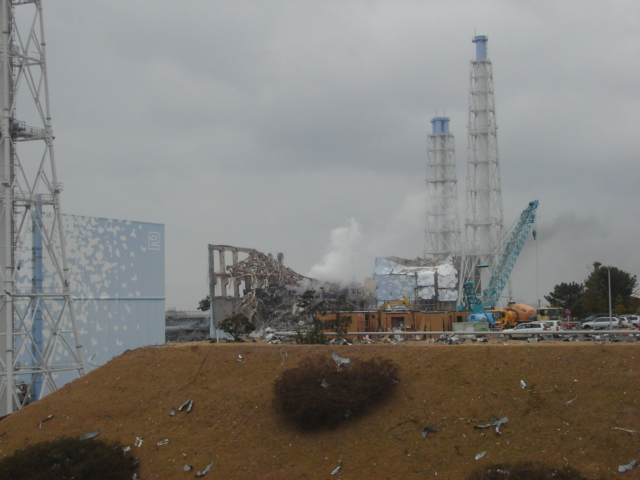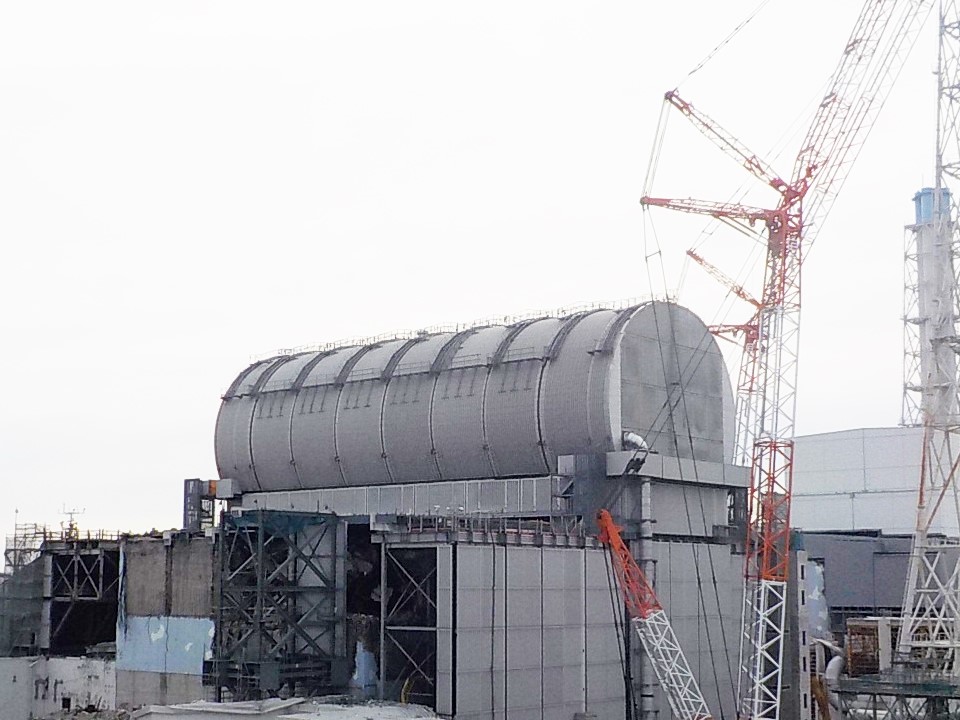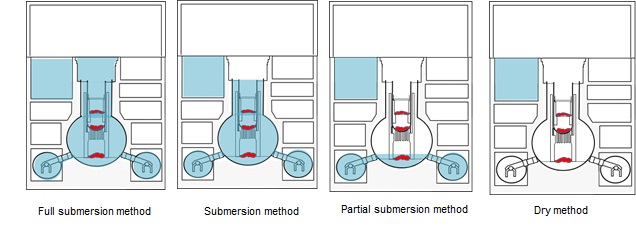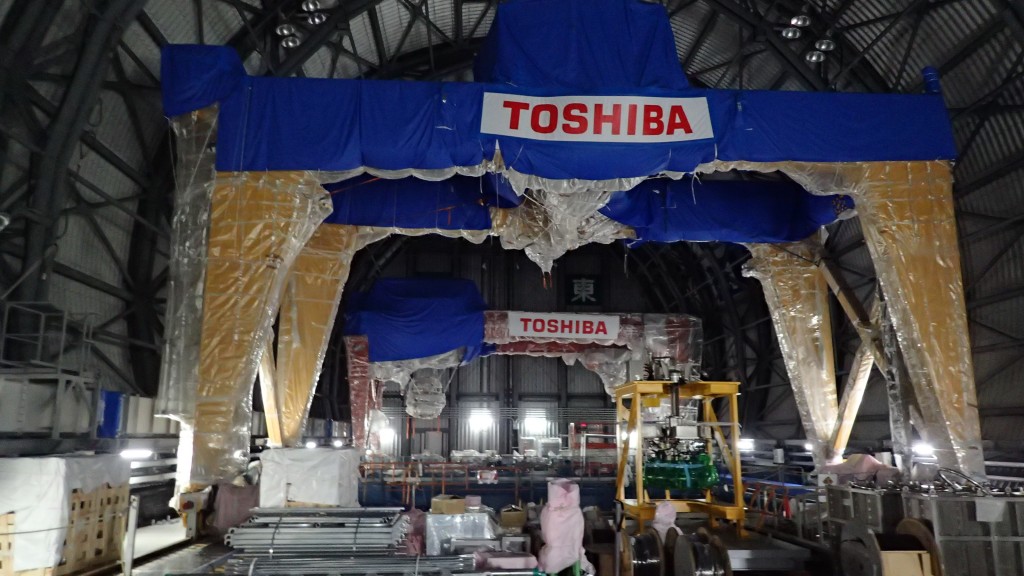Uncertain Future: Fukushima +7
 By Will Davis
By Will Davis
The collective memory of, and indeed, the images conjured by mention of the Fukushima Daiichi accident is still, seven years later, largely that above. We see here, in a photo taken on March 15, 2011, three of the four damaged nuclear units at the site. Unit 2's reactor building stands largely intact at left, but conceals what we soon learned to be a melted reactor. Unit 3 is to the right of it, with steaming reactor building destroyed by the explosion of hydrogen gas. Unit 4 beyond was damaged by the same gas which was pushed over through common gas handling system piping to explode later. Out of view to our left in this photo is Unit 1, heavily damaged by hydrogen gas explosion but in better shape physically than Unit 3.
That's not the case today - in fact, far from it and infinitely better. Years ago the reactors were stabilized; assured shut down and fuel masses cooled. The condition of those masses remained largely speculative until fairly recently, but conditions such as temperature and recriticality (which has never been approached) have been firmly assured from almost the beginning. The damaged buildings seen here are secured, sealed; the debris removed. The site is, for lack of a better word, much more habitable. In fact, it's so markedly improved that the old J-Village, a large personnel and supply staging center miles to the south which used to be the cutoff for personnel not in protective gear, has been shut down and, sometime soon, will become an impressive and world-class soccer training facility.
That isn't to say that the situation is over - far from it. In fact, the future is still fairly uncertain for both TEPCO (owner of the plant) and for Japan in two important ways.

This recent view courtesy Tokyo Electric Power shows today's appearance of Unit 3 at the Fukushima Daiichi plant. The damaged clutter of the refueling floor area structure is gone, and a new domed structure has been put in place containing a crane that will remove the spent fuel from the spent fuel pool. All of the spent fuel from Unit 4, which is out of sight to the left in this photo, was long ago removed safely and found not to have been overheated, much less melted - disproving one common myth about the accident and its progression. See photo at bottom of article for a view inside the dome on Unit 3.
Kashiwazaki-Kariwa and TEPCO's Trust
Although Japan's Nuclear Regulation Agency (NRA) made the first step in the restart process for Kashiwazaki-Kariwa Units 6 and 7 at the end of last year, the prefectural government on this opposite coast to Fukushima has no intention of allowing TEPCO to restart the units any time soon. According to the Governor of Niigata Prefecture, the units cannot be restarted until the full causes of the Fukushima accident are known, which according to World Nuclear News could take up to as much as four more years.
Of course, the cause of the Fukushima Daiichi accident is known, and it's well known; it happened because the entire power plant suffered a station blackout, or SBO. This highly dangerous situation is that which occurs when all electric power on a site is lost, removing the ability to pump water and use instrumentation and control equipment. It's long been known that it is to be avoided at all cost but yet it happened at Fukushima Daiichi - not due to the giant earthquake (which the units appear to have ridden out as expected) but the giant tsunami 45 minutes later that completely overwhelmed the site. Debates still rage today as to whether TEPCO's officials, or the Japanese Government are to blame for the now-proven-inadequate tsunami defense at the Fukushima site.
What the Niigata government might mean more than "how," is "how not to" - and this calls into question among many other things physical separation. Although there may have been some indication from the Three Mile Island and Chernobyl accidents that immediate effects on other units at a site when one of the units experiences an accident might not have been so severe as supposed, Fukushima Daiichi completely rewrote that book. It's in fact safe to say that had Unit 1 not suffered the hydrogen explosion when it did, cutting off efforts to manually supply cooling water and power to the other units by portable means, that the meltdowns at Units 2 and 3 might well not have happened. The consideration of horizontal separation of units as relates to damage also leads, particularly at sites such as this, to consideration of vertical separation as well since all of the bedrock-mounted diesel generators were swamped and failed, while the roof mounted "air cooled" diesels (really, water cooled with local radiators) were able to stay running even if their electrical connections were swamped. Height and horizontal distance clearly matter at least equally now, in terms of separation. (That's part of why mobile protective measures, not unlike the FLEX equipment here, are put on hills near the Japanese nuclear plant sites now.)
It's impossible to tell if TEPCO will meet the Niigata requirements soon, or later, or never. For the most part anti-nuclearism still abounds in Japan, and since the prefectural governments seem to hold the keys even if legally the NRA is in charge, it's come down to placating them when a plant is to restart. What's not vague at all is the fact that TEPCO is continuously bleeding money; according to WNA, the company could pick up $883 million annually if it were able to restart just the two newest units at Kashiwazaki-Kariwa - funding it sorely needs to even think about getting off the government checkbook.
Fuel Removal Not As Originally Planned
Recent investigations by TEPCO in concert with a variety of companies and universities to determine the condition of the melted fuel inside Units 1, 2 and 3 at Fukushima Daiichi has led to the conclusion that all three suffered major meltdowns and with that a considerable loss of fuel material from inside the reactor vessels. Much has been deposited inside the drywell area of each of the units, in varying amounts; Unit 2 remaining the most nearly intact, if that can be used as a term. The upper end fixture of a fuel assembly, complete, has been photographed sticking out of now-solidified debris underneath the reactor vessel of Unit 2 however, meaning that more than pinholes or CRD or instrument tube leaks occurred to convey molten fuel out the bottom of the vessel. Clearly, all three have been destroyed very much to the upper extents calculated by TEPCO and others for the last few years using MELCOR and other programs to determine, theoretically, the conditions.
These revelations as well as structural considerations of the reactor buildings and plant systems themselves (for example, the main steam lines at Unit 3 are known to be leaking) has led TEPCO to consider abandoning its original plan to fill the drywells up with water and defuel the plants roughly conventionally through the top of the drywell, using the large column of water as shielding.

This image, courtesy the Nuclear Damage Compensation and Decommissioning Facilitation Corporation, shows four possible levels of submersion of the damaged fuel material at any of the three affected units at Fukushima Daiichi. Considerations as to which of these is achievable include not only structural integrity of the buildings but the ability to detect and repair leaks in any piping system that could prevent filling of the drywell up to any of the indicated levels. There are also multiple considerations as to how to enter the drywells to defuel, given the final water level - even by coming in from the side or from nearly below. It remains to be seen how this will be decided, but it must be decided in the first half of FY2018 in order for the project to remain on schedule - a schedule that sees final decommissioning activities still 30 or 40 years out.
So, today, seven years after the accident we're still unsure of the future. TEPCO may eventually cease to exist (at least in its present form) if it is never allowed to restart nuclear units and get cash flowing in again. (This author has suggested contract operators for the western Kashiwazaki-Kariwa plant at the start, until trust is regained.) And, on the East coast, even though it's long been known that the dismantling of the damaged nuclear plant would be long and arduous, it's now clear that the defueling of the units will move somewhat along the sliding scale toward the 'more difficult' end. Although we know a great deal more about the past, which is to say the accident scenario and cleanup than we did just a couple of years ago it's clear that the other way - the future - is not yet clear at all.
Further reading: I highly suggest this excellent blog by Heather Matteson of Mothers for Nuclear, who recently traveled to Fukushima and who offers a highly personal and riveting story.
•"Fort St. Vrain in Pictures" will pick up again next week, so be sure to subscribe to the ANS Nuclear Cafe blog. You won't want to miss it!


